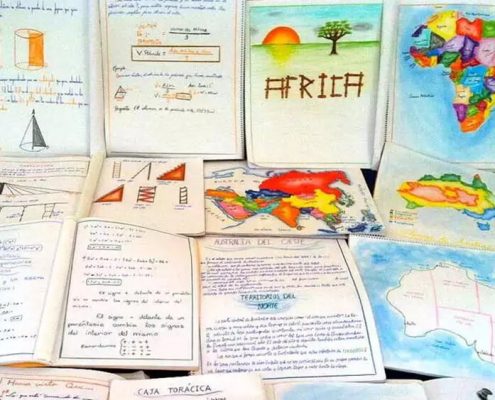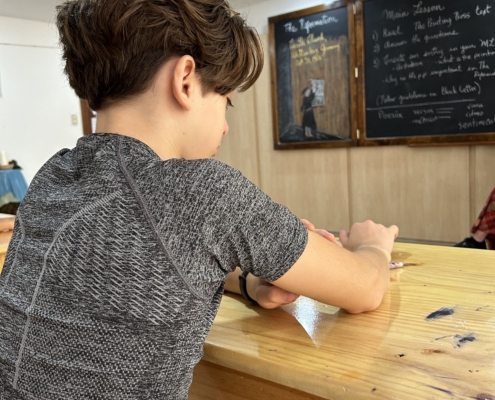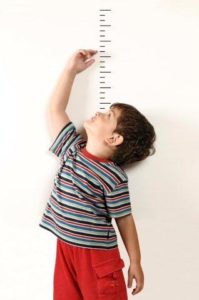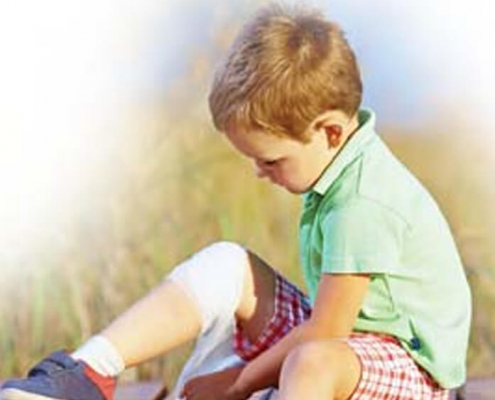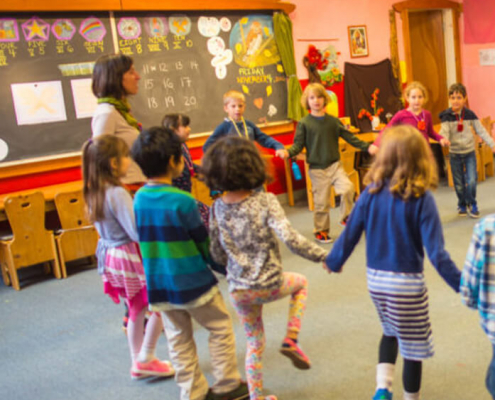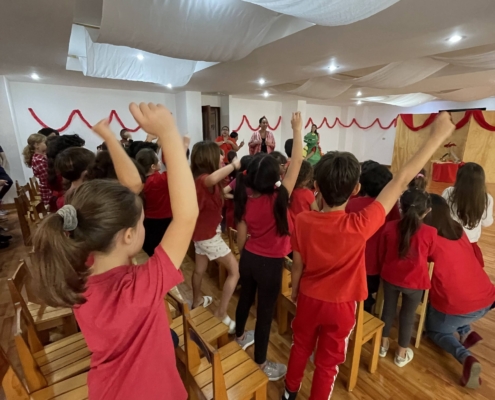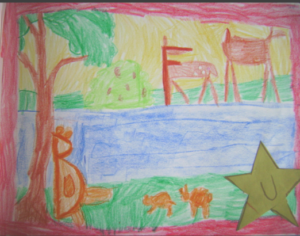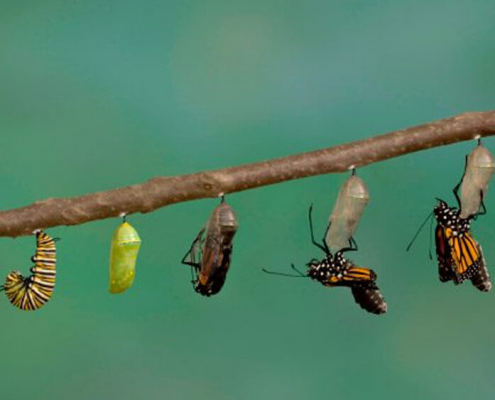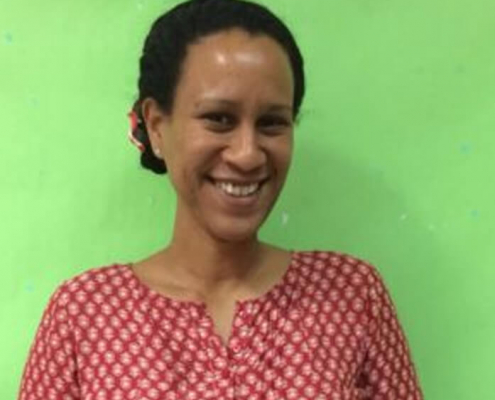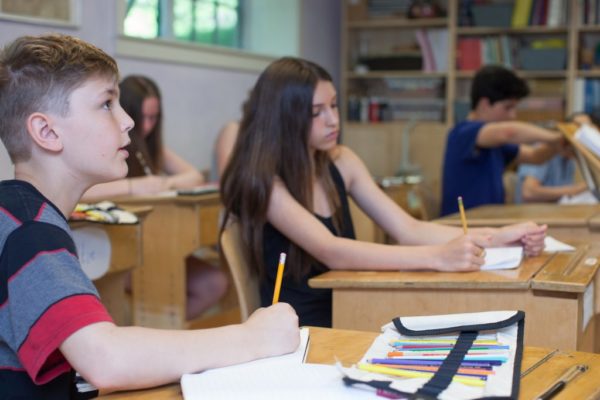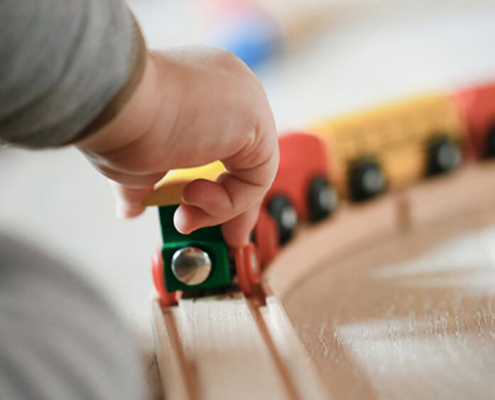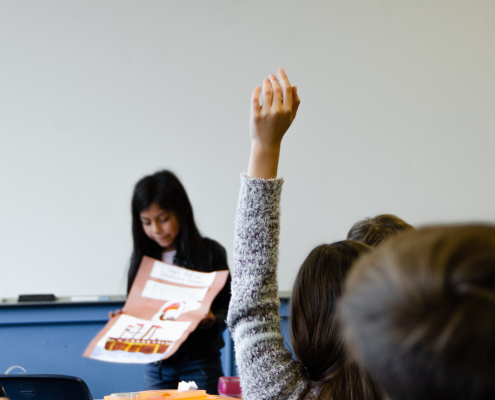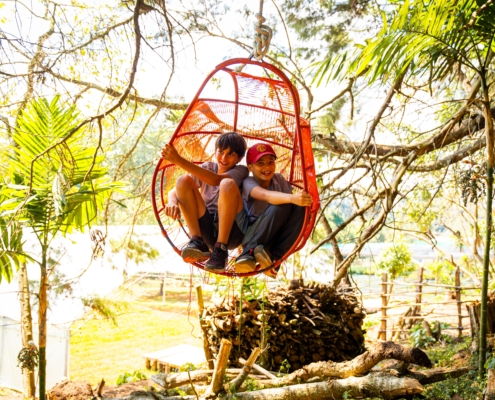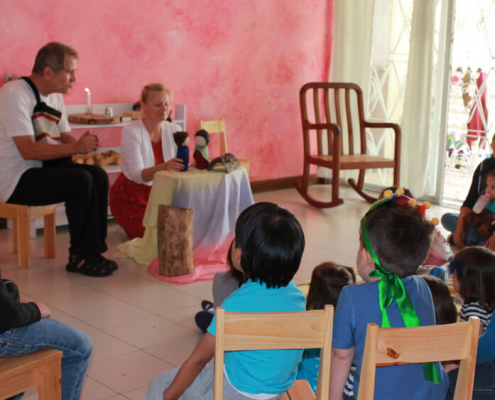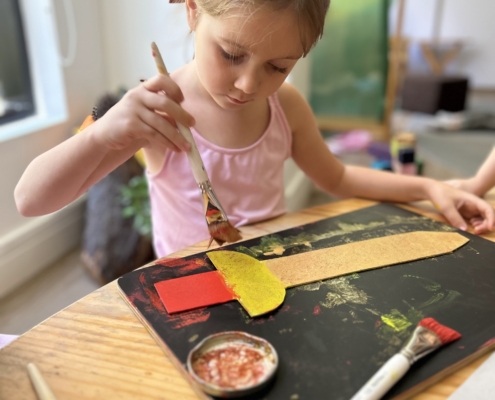Written by Hans Tholken
The sense of life, balance, movement, and touch, which are known as the four lower senses build up three capacities in a child:
- Body Geography – knowing where the parts of your body are.
- Spatial Orientation – knowing where you are in space.
- Dominance – having a preference for one side of your body to do tasks (left –right).
These three capacities are the foundation for all the activities children will perform in school and in their further life. They are basic for all academic learning.
1.Sense of Life
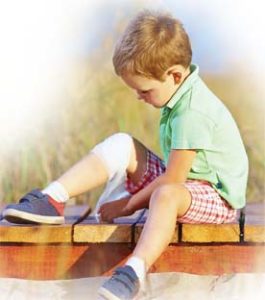
The sense of life informs us about our wellbeing. As long as we are well we are not much aware of our body. We know about the sense of life when we are sick, having an ache, or are tired, or hungry, or thirsty. We feel our sense of life when we had too much alcohol or sugar. We then learn that lack of sleep, loud music, wrong food, or a too tight schedule does not support our health. The sense of life teaches us to pay attention to our body. It helps us to get enough sleep, to eat well, and to rest when you are sick.
There is another interesting aspect: the sense of life also teaches us to suffer in the right way. Children may experience a bruised knee, the fall of a bike, the toy you won’t buy for them, the dessert they will not get. This way, children learn to deal with disappointments. Children learn to ride the bike more safely, or to be more patient and so become wiser.
Before the industrial revolution, we were living by the rhythms of nature. We got up with the sun (or a little earlier) and went to bed at dark. Families gathered around the dinner table sharing healthy, wholesome food, sang, and listened to stories grandfather might have told.
Due to electric power our day span is much longer. We divide our days between working hours and free time, and there are lots of activities (work out, theater, concert, reading) and “passivities” (watching TV, surfing the internet) we want to squeeze in between the “happy hour” and midnight.
Many children have an overloaded schedule after school and parents drive them around to activities like karate, soccer or ballet sacrificing their own evenings.
Children and parents suffer from being in a treadmill! Maybe this is the reason some children are having trouble falling asleep.
“Rhythm restores power”
Children need daily rituals and routine! They need to play, do chores, move and rest, and they need to experience quiet and boredom – out of boredom rises creativity! Children need to become physically tired to fall asleep easily and wake up with bright eyes.
Nutrition plays an important part to support the wellbeing. Children need enough protein, vegetables, fruits and proper fat for brain development. Best fats are fresh butter, chicken fat, olive – sesame – and flax oil, and whole milk.
Children up to the age of 7 need protection for their inner organs by warmth. They don’t have yet an awareness of their body and like to sneak away without the necessary layers.
It is crucial to keep our children protected from all the media, screens and news of the world. Children beyond 10 years of age are able to face the fact that the world isn’t always good, but there is also a shadow side of humanity.
How we can support a healthy body and mind.
- Warmth: Layers appropriate for the seasons.
- Rhythm: Establish one ritual every day, stick to it. Then add more when you feel comfortable.
- Screens and media: Limit screen time as much as you can. Do not discuss sensitive topics in front of children.
- Sleep: Read a story before bedtime between 7 and 8 the latest. Of course there are exceptions on special occasions.
- Nutrition: Good fats, wholesome foods, limit carbohydrates and sugar. Plenty of fruits, raw veggies, and small protein portions.
2.Sense of Balance / Vestibular system

The vestibular system has to do with balance and movement and is centered in the inner ear. Each of us has vestibular organs located deep inside our ears.
It also works right alongside all of our other sensory systems, helping us use our eyes effectively and process sounds in our environment. Overall, vestibular processing helps us feel confident moving and interacting with our surroundings.
When a child’s vestibular system is not functioning correctly, he may be under responsive or overly sensitive to movement. The child may either need to move constantly to feel satisfied or he may be fearful of movement because it makes him feel insecure and unbalanced. He may move in an uncoordinated, clumsy manner, bumping into things, falling, and never fully walking or sitting in an upright manner. This is the child that is constantly being directed to “stand up straight” or “stop leaning on the wall!” He may appear weak or “floppy”.
What exercises can strengthen the sense of balance?
- Crossing midline excersises
- Walking over balance beam, log
- Standing on one foot, more advanced with closed eyes, or bean bag on the head, or tossing and catching a bean bag
- Walking heel to toe (closed eyes, beanbag)
- Walking sideways
- Walking on a tight rope on the floor, first sideways, then heel to toe (closed eyes, bean bag)
- Jump rope
- Cartwheel
- Wheelbarrow
- Headstand
- Walking on stilts
- Hopscotch
- Swing
- Slide
- Hanging upside down
3.Sense of Movement / Proprioception
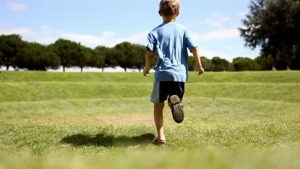
Proprioception refers to the body’s ability to sense movement within joints and joint position. This ability helps us to know where our limbs are in space without having to look. It allows us to form a muscle memory we need for writing or playing a musical instrument or using all kinds of different tools properly.
This body sense is more than just a feeling of movement. It is tied to our feeling of muscle tone, perception of effort and, most importantly, our perception of balance.
The sense of self-movement brings great satisfaction to the children as they learn how to bring their arms and legs into their control and reach out for something they want. Over the first year of life, this sense leads the child to stand and take the first steps – one very important step in the early childhood.
The baby needs lots of opportunities to be in the horizontal plane. Its development depends on this. On the floor the baby responds to a pushing reflex, pushing against surfaces with hands and feet to lift the heavy head and eventually roll over, move forward, backwards or sideways. This is a very important part for the development of the child’s will (the drive to take action).
The infant develops a relationship to earth and the space around it. Developing our orientation to the earth properly while still in horizontal plane helps us to become fully upright. If a child missed out on floor time, then spatial orientation is compromised. Leaving children for long periods in infant seats weakens their motor development as well as their will development. The children cannot turn their heads fully to one side or the other. It also affects the eye tracking and neck reflexes.
Also, too much time in cars, too much time in front of screens and organized sports before the age of 9 compromise free movement. This lack of free movement can be seen in children struggling to sit at a desk, or write properly on a page.
If spatial orientation is properly developed children have a better understanding of which way letters and numbers go: top – bottom, left – right. Children need sufficient time in the horizontal plane to develop spatial orientation, that is the body’s internal map, as well as to develop strong will forces. Not having had enough floor time can lead to a lack of crawling, which compromises eye tracking and the ability to hold the head up free from the movement of the limbs. Reading and copying from the chalkboard can become a struggle. Lack of crawling can also compromise hand development or fine motor skills. Ideally a child should crawl for 3 months. Hands flat – no curved fingers.
Children need sufficient time in the horizontal plane to develop spatial orientation (body’s internal map) as well as to develop strong will forces.
Children need free play, nature time, playground visits. They should freely move. Children need daily free movement and opportunities to lift objects!
Lack of lifting opportunities show up as
- Restlessness
- Sluggishness
- Continual pushing behavior
Chores that support the lifting system
- Carry in groceries
- Carry the laundry bag
- Carry tools like vacuum, rakes, shovels
- Lift branches, rocks or bricks
- Carry bag of potting soil
Connection between movement and speech
Children who have had sufficient movement experiences, often have fewer speech problems (assuming that speech is natural, correct, and not from a machine like TV or computer). If children have not mastered the R-sound or other sounds by the age of eight or nine, parents might want to consult with a speech/language therapist.
- Sense of Touch

Already in the process of labor the newborn child received a strong impression of squeezing, pushing and meeting a boundary. Through a natural birth the newborn had a substantial experience of touch. If a child has experienced a fast birth (under 3 hours), or a caesarian birth then the sense of touch might not have been strong enough. In many cultures babies are firm swaddled for the first 3 months. Through this firm pressure the child gets a sense of safety.
Also through our many layers of clothing we learn where we end and where something else begins. Touch helps us to learn about boundaries.
Issues like tactile defensiveness may arise when the sense of touch has not received enough stimulation in the early years. This child may experience a light brush against the arm as a strong push, causing an overreaction.
Some children with tactile sensitivity seek out for firm touch by crashing into people or objects. All this help the children to get a feedback They need to feel how their bodies, their muscles and joints are in relation to the world around them.
These children may also wake up in the night not feeling a boundary – “where am I?” and want to sleep with mom and dad in their bed. Snuggling next to an adult provides the missing boundary.
On the contrary: some children may show tactile defensive issues like resist wearing layers of natural fibers, which are heavier than synthetic fibers, or resist wearing snug clothing, preferring a loose style. Another indicator might be, not liking hugs or dislike of haircut or crowds.
What can we do?
Below you can find some suggestions to help the child develop their sense of touch. Apply as much as your child is comfortable with it.
- Playing “flying angels”, dad on his back, on his outstretched feet the child
- Wrapping in blankets
- Playing in sandbox
- “Magic millet” finding hidden gems
- Bear hugs
- Run and crash into a stack of cushions
- Handclap games
- Rolling on the floor or grass
- Sandwich the child between cushions and put some pressure on them
- Roll the child in a futon
- Firm massage
- Put pillows on either side of the child when sleeping, or sleeping bag




